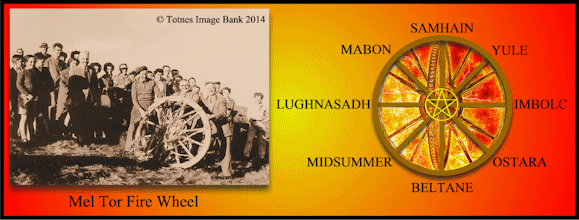
“This wheels on fire, rolling down the road
Best notify my next of kin
This wheel shall explode.”
Bob Dylan & The Band – 1967
There is a fourth century record of pagans in Aquitaine celebrating the coming of Midsummer by rolling a flaming wheel downhill into a river. Some thousand years later a similar practice was taking place at Winchcombe in the Cotswolds on midsummer’s Eve. In the 1820s the following description of wheel rolling was given for South Glamorgan:
“People conveyed trusses of straw to the top of the hill, where men and youths waited for the contributions. Women and Girls were stationed at the bottom of the hill. Then a large cart wheel was thickly swathed with straw and not an inch of wood was left in sight. A pole was inserted through the centre of the wheel, so that the long ends extended about a yard on each side. If any straw remained, it was made up into torches at the top of tall sticks. At a given signal the wheel was lighted and set rolling downhill. If the fire-wheel went out before it reached the bottom of the hill, a very poor harvest was promised. If it kept lighted all the way down, and continued blazing for a long time, the harvest would be exceptionally abundant. Loud cheers and shouts accompanied the progress of the wheel.”
All very interesting but what has it to do with Dartmoor? It appears that this old custom was also held on the moor, the earliest example being at Buckfastleigh on Midsummer’s Eve. Here in the mid 1850s the flaming wheel would be guided down the Bonfire Hill by the use of sticks. If it reached the stream then the whole community would be guaranteed a year of prosperity and good fortune. If it didn’t then maybe it was time to move house just to be on the safe side.
In 1954 the custom once again took place on Midsummer’s Eve, this time the slopes of Mel Tor was the location and the river Dart was the hopeful destination for the wheel. As before if the wheel reached the river good fortune would fall upon the villagers of Widdecombe. Eric Hemery notes:
“An old custom on Mil Tor (Mel Tor) was the ‘Rolling of the Wagon Wheels’ on Midsummer Day: discontinued in the war years, it was revised for a time during the late 1950s, since which it has again lapsed. The aim was that the wheels should reach the river, but so rock-strewn is the six-hundred foot slope that few ever did. In consequence, the old iron tyres of long-rotted wheels lie about Miltor Wood – some now encircling the trees.“, p.587.
In 1962 the custom was once again revived on Mel Tor but instead of setting the cart wheel alight streamers were tied to it thus giving a flame effect.

But what is the significance of a flaming wheel rolling downhill on Midsummer’s Day or Eve? As can be seen above there are notable days in the old pagan ‘Wheel of Life’ and Midsummer occurs at halfway through the cycle. This is the time of year when in theory the days begin to get shorter and the clock slowly begins its countdown into winter. This would be a time when crops are ripening and livestock growing, all of which would provide vital food sources for when the barren winter months arrive. It was therefore important that such resources were abundant and to help ensure this numerous ceremonies and rites were carried out asking the gods for their favour. The significance of fire on this day reflects the awe and respect shown to the sun and its vital part played in ripening crops etc. Additionally the flames and smoke acted as a purifier to dispel any evil which could impair future fortunes. It could be said that the attempt to roll the wheel into water was again suggestive of a much needed aspect of a fruitful harvest
Therefore the combination of a wheel which represented the ‘Wheel of Life’, the flames which represented the sun along with the desire for the wheel to end up in a water source all amounted to a celebration of this time of year. It also symbolised people asking for divine intervention to provide prosperity and fruitful harvests for the community.
What is the significance of rolling a wheel downhill? Probably because it would be rather difficult and dangerous to get it to roll uphill. Or more seriously as water appeared to play such an important part in the ritual it would be the most commonest and convenient to find such a source.

 Legendary Dartmoor The many aspects past and present of Dartmoor
Legendary Dartmoor The many aspects past and present of Dartmoor
